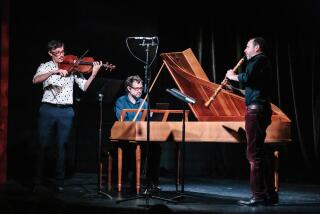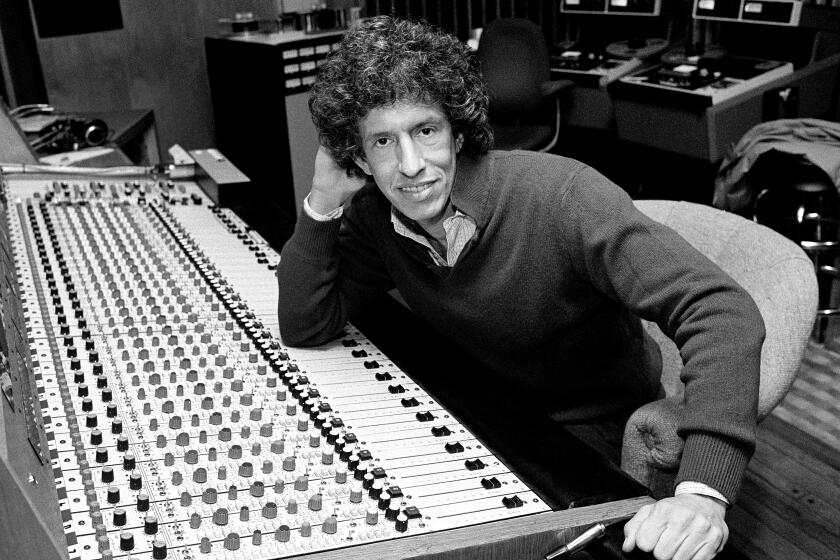There’s More to the Music Than Saxes and Pianos
- Share via
Listening to Toots Thielemans rip off one bebop lick after another, soaring across the harmonic spectrum with the creative imagination of a world-class jazz improviser, it’s hard to believe that the instrument he is playing is the humble harmonica.
But that’s what it is. And doubters are referred to the Jazz Bakery this week, where the Belgian artist begins a six-night run on Tuesday.
Actually, Thielemans’ instrument is a chromatic harmonica, considerably more sophisticated than the basic diatonic version common to pop and blues music. With it, he has all 12 semitones of the chromatic scale available (think of the piano’s black and white keys), rather than simply the seven notes of the diatonic scale (think of the piano’s white keys). And, like classical/pop harmonica virtuoso Larry Adler, Thielemans has used this potential to create an array of music with virtually no technical limitations on what had previously been viewed as a novelty instrument. (And this is not to minimize the sometimes remarkable performances of such quirky ensembles as the Harmonicats and Borrah Minevich’s Harmonica Rascals.)
But the harmonica, despite the impressive playing of Thielemans, Howard Levy and German musician Hendrik Meurkens, remains in the indefinable jazz category usually referred to as “miscellaneous instruments.” In jazz magazine polls, the category has consistently been won by Thielemans, who not only plays harmonica but who also adds another unusual sound to the jazz lexicon when he plays his first instrument, the guitar, by doubling his melody lines with simultaneous, unison whistling.
Thielemans’ harmonica is in the company of such unusual, one-shot associates as the bagpipes, the goofus, the hot fountain pen and the slide saxophone (as well as Rahsaan Roland Kirk’s beyond-category collection of stritch, manzello, clavinet, etc).
There are, however, any number of miscellaneous instruments that--like the harmonica--have made and continue to make contributions to jazz. It’s worth remembering that the now-common sound of flutes, electric organs and synthesizers a few decades ago would have seemed like alien elements in the jazz mainstream. And a good part of the music’s tenacious capacity to survive is associated with its ability to change, evolve and grow, stylistically, as well as in the sound of its instruments.
Take the woodwinds, for example. Players in early jazz bands commonly doubled on a variety of saxophones and clarinets. By the Swing Era, the practice diminished to the point where the basic woodwind battery consisted of alto, tenor and baritone saxes and B-flat clarinets.
In the ‘50s and ‘60s, the soprano sax--often described, inaccurately, as difficult to play in tune--was rediscovered in the brilliant work of Steve Lacy and John Coltrane. Eric Dolphy brought the bass clarinet back to life, and Yusef Lateef uncovered the oboe’s blue notes. Perhaps most remarkable of all, reedman Ray Pizzi transformed the thorny, buzzing sound of the bassoon into a credible jazz utterance.
Among the brass instruments, the fluegelhorn, a mellow-sounding version of the trumpet, was heard only rarely (Shorty Rogers played it in the early ‘50s) before Miles Davis used it on the album “Miles Ahead” in 1957. Since then it has become commonly used, and is especially prominent in the work Art Farmer, Chuck Mangione and Clark Terry.
The French horn, a difficult instrument, has been frequently used for textural purposes (the Miles Davis “Birth of the Cool” sessions), with Julius Watkins one of the few who used it productively as an improvising instrument. Other brass that have appeared sporadically have been tuba (Howard Johnson), bass trumpet (Cy Touff), bass trombone (George Roberts) and mellophoniums (notably in Stan Kenton’s mellophonium band of the early ‘60s).
In the general area of rhythm section and stringed miscellaneous instruments, David Grisman has made the mandolin into an attractive jazz voice, as has Bela Fleck with the banjo and Colin Walcott on sitar. Dave Samuels and Andy Narell--especially in their work with the Caribbean Jazz Project--have added marimba and steel pans, respectively, to the mix. Steve Turre has uncovered an amazing amount of music in conch shells, Richard Galliano is one of several performers reviving the jazz accordion, and Airto Moreira (following in the footsteps of Chano Pozo, Mongo Santamaria and Tito Puente) brought the array of sounds grouped together under the title “percussion” to the jazz rhythm section.
Thielemans will be working with a traditional rhythm section at the Jazz Bakery. How much more interesting it might be to hear his harmonica accompanied by, say, Fleck’s banjo, Galliano’s accordion, Johnson’s tuba, Narell’s steel drums, Moreira’s or Trilok Gurtu’s percussion and, as front-line associates, David Murray’s bass clarinet, Turre’s conch shells and Regina Carter’s violin. Now that would be a miscellaneous instrument band deserving of its own category.
*
* The Toots Thielemans Quartet, Jazz Bakery, 3233 Helms Ave., Culver City. Wednesday to Saturday, 8:30 and 10:15 p.m.; next Sunday, 4 and 8 p.m. $18-$22. (310) 271-9039.
More to Read
The biggest entertainment stories
Get our big stories about Hollywood, film, television, music, arts, culture and more right in your inbox as soon as they publish.
You may occasionally receive promotional content from the Los Angeles Times.










